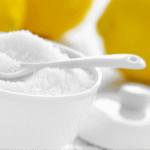You see fumaric acid in lots of foods. It helps control how sour foods taste. It makes flavors stronger. It helps food stay fresh longer. It also makes food feel better when you eat it. Groups like EFSA and FDA check how much fumaric acid is used. They make sure it is safe for people.
- EFSA checks how much fumaric acid people can eat. It also looks at how it is used.
- FDA keeps track of rules for fumaric acid. It also checks if it is safe in foods.
You can trust that fumaric acid follows strict safety rules. It helps make good food that is safe to eat.
Fumaric Acid Overview
Key Physical and Chemical Properties of Fumaric Acid
Fumaric acid is important in food processing. It is a white powder with no smell. It tastes very sour, even more than citric acid. You can see its main facts in the table below:
| Property | Detail |
|---|---|
| Molecular Formula | C4H4O4 |
| Molecular Weight | 116.07 |
| Chemical Name | Fumaric acid (trans-2-Butenedioic acid) |
| Appearance | White, odorless crystalline powder |
| Structure Type | Unsaturated dicarbonic acid |
| CAS Number | 110-17-8 |
| Melting Point | 298-300 °C (sublimation) |
| Solubility | 0.63 g/100 mL (water, 25°C) |
| pKa Values | 3.02, 4.38 (at 25°C) |
| Odor | Odorless |
Fumaric acid does not mix well in cold water. It mixes better in hot water. This lets you control how fast it blends into foods. It does not take in much water from the air. This stops powdered foods from sticking together. You can use it in dry foods like cake mixes or drink powders. It has a high melting point and strong structure. It stays safe and stable when you bake or cook with it.
Tip: Fumaric acid is strong and does not break down easily. It helps food stay fresh and taste good for a long time.
Natural and Industrial Sources of Fumaric Acid Used in Food Processing
Fumaric acid is found in nature. It is in fruits like apples, grapes, and berries. It is also in vegetables like tomatoes and carrots. These foods taste tart because of this acid.
| Fruit/Vegetable | Typical Fumaric Acid Concentration |
|---|---|
| Grape berries | 0.07 to 10.69 mg/L |
| Wines | Less than 31 mg/L |
| Apples | Presence confirmed |
| Berries | Presence confirmed |
| Tomatoes | Presence confirmed |
| Carrots | Presence confirmed |
Factories need more fumaric acid than plants can give. They make it in two main ways:
- Chemical synthesis: Workers use oil-based stuff to make fumaric acid. This way makes a lot but can hurt the environment.
- Fermentation: Scientists use fungi like Rhizopus to turn sugar into fumaric acid. This way is better for the planet and uses things that grow back.
Both ways make fumaric acid that is safe for food. Many companies want to help the earth, so they use fermentation more now.
Key Functions and Roles of Fumaric Acid in Food Processing
How Fumaric Acid Controls Acidity and Maintains Optimal pH Levels in Food
You need to keep the right level of acidity in food to make it taste good and stay safe. Fumaric acid helps you do this because it is a strong acidulant. It lowers the pH in foods like bread, drinks, and sauces. When you use fumaric acid, you need less of it than other acids, such as citric acid, to get the same sour effect. For example, you only need 2 parts of fumaric acid to do the job of 3 parts of citric acid. This means you can use less and still get the results you want.
- Fumaric acid has a higher acidity constant than many other acidulants.
- It gives you better control over pH and helps keep food stable.
- It does not absorb water from the air, so it works well in dry mixes and powders.
Note: Fumaric acid also helps keep food safe by making it harder for germs to grow. This is because many bacteria and molds cannot live in acidic conditions.
How Fumaric Acid Enhances and Balances Flavor Profiles in Food
When you want food to taste just right, you need to balance sweet, sour, and other flavors. Fumaric acid gives a strong, clean sour taste that lasts longer than other acids. You often find it in sour candies and soft drinks. It makes these foods taste tart and exciting, especially for kids and teens who love sour treats.
Fumaric acid works well because you need only a small amount to get a big effect. It does not take in moisture, so it keeps candies from getting sticky. In drinks, it brings out the fruit flavors and keeps the taste fresh. Some studies show that people notice a difference in taste when they try drinks with fumaric acid compared to other acids. Over time, people may even start to prefer the taste of foods with fumaric acid.
How Fumaric Acid Preserves Food and Extends Shelf Life
You want your food to stay fresh as long as possible. Fumaric acid helps by stopping the growth of bacteria, molds, and yeasts. It acts as a preservative and keeps food safe during storage. When you add fumaric acid to foods like bread, juice, or meat, it can make them last longer without spoiling.
- Fumaric acid has strong antimicrobial activity.
- It helps reduce the need for other preservatives.
- It keeps food safe and fresh by lowering the pH and stopping germs.
| Treatment | Conditions | Pathogen Reduction (log CFU/g) | Shelf Life Extension (days) |
|---|---|---|---|
| Slightly acidic electrolyzed water (SAcEW) + 0.5% fumaric acid | 40°C for 3 minutes | E. coli O157:H7: 2.59, L. monocytogenes: 2.69, S. aureus: 2.38, S. Typhimurium: 2.99 | Up to 6 days at 4°C, 4–5 days at 10°C |
| Untreated fresh pork | N/A | No significant reduction | Baseline (no extension) |
This table shows that adding fumaric acid can help keep foods like pork fresh for up to 6 days longer in the fridge.
How Fumaric Acid Improves and Modifies Food Texture and Consistency
Texture is important in foods like bread, cakes, and candies. Fumaric acid helps make dough stronger and more elastic. This means your bread will rise better and have a softer crumb. When you use encapsulated fumaric acid, it reacts slowly with baking soda. This slow reaction helps trap more gas in the dough, making bread lighter and fluffier.
- Fumaric acid increases dough stability and strength.
- It helps bread keep its shape and improves the crumb texture.
- It also helps keep bread fresh by stopping mold growth.
Tip: If you want to make bread that stays soft and tasty longer, try using fumaric acid in your recipe.
Common Applications of Fumaric Acid in the Food Industry

Bakery Applications: Enhancing Bread Quality and Shelf Life
Fumaric acid is used in breads like tortillas and flat breads. It helps bread stay fresh by lowering the pH. This slows down mold growth. When you mix it with other preservatives, it works even better. Fumaric acid also makes dough easier to work with. It relaxes gluten and improves bread texture. Sometimes, bread can get big blisters or clear spots. This happens if fumaric acid reacts too soon with baking soda. Bakers use encapsulated fumaric acid to stop this problem. It releases at the right time during baking. Studies show fumaric acid with sodium propionate keeps bread soft longer and delays staling.
Beverage Applications: Enhancing Taste and Stability in Drinks
Fumaric acid is in powdered drink mixes and fruit juices. It gives drinks a strong tart taste that lasts. It keeps flavors stable over time. Fumaric acid lowers the pH and stops bacteria and molds. This keeps drinks safe and fresh. In wine, it helps control fermentation and stops bad bacteria. This keeps the flavor just right. In soft drinks, fumaric acid works with other preservatives. It helps keep color and taste stable. Its strong acid strength means you need less to get the sour taste.
Tip: Fumaric acid helps drinks taste fresh and last longer, even in hot or humid weather.
Confectionery Applications: Improving Candy Texture and Flavor
Fumaric acid is found in sour candies, gummies, and jellies. It gives these treats a sharp tart taste that lasts. It does not absorb moisture, so candies stay dry and do not stick. Fumaric acid helps keep flavor and texture good. Your treats taste nice even after sitting on the shelf. In chewing gum, it adds sour flavor and keeps gum soft.
Dry Mix Applications: Improving Stability and Functionality in Powdered Foods
Fumaric acid works well in dry mixes like cake powders, instant drinks, and supplements. Its solid form keeps powders flowing and stops clumping, even when it is humid. It lowers the pH and stops spoilage. It keeps flavors stable. You only need a little to get a strong tart taste. This helps control costs and keeps products stable. The table below shows how fumaric acid helps different powdered foods:
| Powdered Food Product Category | Role of Fumaric Acid |
|---|---|
| Baked Goods | Improves dough stability, texture, and shelf life |
| Confectionery | Provides tartness, flavor enhancement, preservation |
| Dietary Supplements | Acts as a binding agent and antioxidant |
| Chewing Gum | Adds sour flavor and improves texture |
Benefits of Using Fumaric Acid in Food Processing
Economic Benefits of Fumaric Acid
When companies pick acidulants, price is important. Citric acid is the most popular because it is cheap and easy to make. It takes up about 60% of the world market. In 2023, it cost about $1,100 for one metric ton. Fumaric acid costs more because it needs special materials and harder steps to make. This makes it less common in foods where price matters a lot.
But fumaric acid gives other good things. It is a clean-label acidulant and preservative. This helps companies make foods that people want, like natural foods. Fumaric acid is strong, so you use less of it. This can help cut down on waste and spoilage. Some companies say bio-fermented fumaric acid is better for the planet. It can lower carbon footprint and supply costs, especially in Asia. If you make high-quality foods, fumaric acid can help your products stand out. It may even help you sell more.
Tip: Fumaric acid lets you make special foods that health-focused shoppers like.
Stability and Performance of Fumaric Acid
You want ingredients that work well in tough situations. Fumaric acid stays strong when you bake or heat it. It keeps its sour taste and preservative power, even in hot ovens. This makes it great for baked foods and dry mixes.
Fumaric acid also works better than some other acids. It keeps pH steady, which helps food last longer. It makes dough stronger and improves taste and texture in bread and cakes. In candies and drinks, it gives a long-lasting tart flavor and keeps tastes fresh. You can buy fumaric acid as powder, granules, or liquid. This means you can use it in many recipes.
| Performance Benefit | Description |
|---|---|
| Heat Stability | Stays strong during baking |
| pH Control | Helps food last longer and stay safe |
| Flavor Enhancement | Makes foods more tart and tasty |
| Versatility | Works in many kinds of foods |
Fumaric Acid: Regulation and Safety
You need to know your food is safe. Experts have checked fumaric acid and say it is safe for people. The Cosmetic Ingredient Review Panel says fumaric acid is normal in your body and helps make energy. Studies show it is not harmful at normal amounts. The Joint FAO/WHO Expert Committee on Food Additives says you can eat up to 6 mg for each kilogram you weigh.
Europe and North America allow fumaric acid in foods. You can trust it meets strict safety rules. Studies show it is safe unless you eat a lot more than normal. This means you can use fumaric acid in your foods and feel sure it is safe.
Note: Fumaric acid is safe and helps you follow food safety rules everywhere.
You help pick foods that are safe and good quality. When you read food labels, you find ingredients that keep food fresh and tasty. Studies say food additives like acidulants and preservatives make food taste better. They also help food last longer and stay safe to eat. The food industry uses these in bread, drinks, and snacks. This is because more people want these foods. Many people now want natural and clean-label foods. So, companies try to find better ways to make these ingredients. What you choose to buy helps decide what foods will be made in the future.
FAQ
What foods commonly contain fumaric acid?
You find fumaric acid in breads, tortillas, powdered drink mixes, sour candies, and some fruit juices. Many dry cake and dessert mixes also use it. You may see it listed as an ingredient on food labels.
Is fumaric acid safe to eat every day?
Yes, you can safely eat foods with fumaric acid. Food safety groups like the FDA and EFSA have tested it. They set safe limits for how much you can eat. You do not need to worry when you eat normal amounts.
Why do food companies choose fumaric acid over other acids?
You get a strong sour taste with less product. Fumaric acid does not absorb water, so it keeps powders dry. It also helps food last longer. Companies use it when they want stable, long-lasting flavor and texture.
Does fumaric acid affect people with allergies?
Fumaric acid does not cause common food allergies. You can eat it even if you have allergies to nuts, dairy, or gluten. Always check food labels for other ingredients if you have allergies.
Can you use fumaric acid at home in recipes?
Yes, you can use food-grade fumaric acid in baking or candy making. Use small amounts for sour flavor or to help dough rise. Always follow recipe instructions and measure carefully.
Tip: Start with a tiny amount. Fumaric acid tastes much stronger than lemon juice or vinegar.



